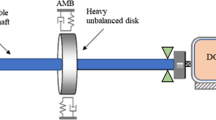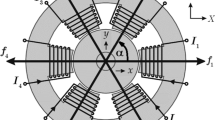Abstract
Purpose
Non-ideal high-speed rotors often exhibit the Sommerfeld effect characterized by nonlinear jumps and eventually gets destabilized. This paper presents a bifurcation analysis to attenuate the jumps in a non-ideal internally damped DC motor-driven shaft-disk system via magnetorheological (MR) fluid damper.
Methods
A nonlinear hyperbolic tangent model of MR damper is proposed and linearized using equivalent linearization technique. To meet the demands of reliable engineering design, the system parameters of the proposed MR model are optimized using genetic algorithm (GA) with the consideration of parametric uncertainty. Then the system equations of the non-ideal rotor system are derived using Lagrangian formulation. Following, a characteristic equation of fifth-order polynomial in rotor speed is obtained through energy balance. The steady-state response is studied with the help of control current of the MR damper and subsequently verified through a bifurcation analysis with the help of root locus technique. A few results are also validated with earlier works.
Results
The nonlinear jumps are found to be attenuated as the control current of MR damper increases. The root locus technique confirms the jump phenomena though the existence of multiplicity of roots of the characteristic equation considering supply voltage as a gain. The proposed saddle-node bifurcation study confirms the cessation of the Sommerfeld effect when two unstable (saddle) points are found to be degenerated into a stable node at a specific bifurcation value of the MR control current.
Conclusion
The nonlinear jumps of non-ideal rotor can be attenuated by altering the control current of the MR damper. This study also suggests that MR-based semi-active strategy is more effective than the AMB-based active control as the former takes much lesser current to attenuate the jumps. MR-based attenuation is found to be safer and more reliable than its active counterpart, i.e., AMB as the overall natural frequency of MR-based non-ideal rotor is far more behind the instability threshold of the system.








Similar content being viewed by others

References
Sommerfeld A (1902) Beiträge zum dynamischen ausbauder festigkeitslehe. Phys Z 3:266–286
Dasgupta SS (2011) Sommerfeld effect in internally damped shaft-rotor systems. PhD dissertation. IIT Kharagpur
Felix JLP, Balthazar JM (2009) Comments on a nonlinear and nonideal electromechanical damping vibration absorber, Sommerfeld effect and energy transfer. Nonlinear Dyn 55:1–11. https://doi.org/10.1007/s11071-008-9340-8
Bolla MR, Balthazar JM, Felix JLP, Mook DT (2007) On an approximate analytical solution to a nonlinear vibrating problem, excited by a nonideal motor. Nonlinear Dyn 50(4):841–847
Warminski J, Balthazar JM, Brasil RMLRF (2001) Vibrations of a non-ideal parametrically and self-excited model. J Sound Vib 245:363–374. https://doi.org/10.1006/jsvi.2000.3515
Felix JLP, Balthazar JM, Brasil RMLRF (2005) On tuned liquid column dampers mounted on a structural frame under a non-ideal excitation. J Sound Vib 282:1285–1292. https://doi.org/10.1016/j.jsv.2004.05.006
Balthazar JM, Mook DT, Weber HI et al (2003) An overview on non-ideal vibrations. Meccanica 38:613–621. https://doi.org/10.1023/A:1025877308510
Dimentberg MF, McGovern L, Norton RL et al (1997) Dynamics of an unbalanced shaft interacting with a limited power supply. Nonlinear Dyn 13:171–187. https://doi.org/10.1023/A:1008205012232
Samantaray AK, Dasgupta SS, Bhattacharyya R (2010) Sommerfeld effect in rotationally symmetric planar dynamical systems. Int J Eng Sci 48:21–36. https://doi.org/10.1016/j.ijengsci.2009.06.005
Samantaray AK (2009) On the non-linear phenomena due to source loading in rotor-motor systems. Proc Inst Mech Eng Part C J Mech Eng Sci 223:809–818. https://doi.org/10.1243/09544062JMES1279
Dasgupta SS, Samantaray AK, Bhattacharyya R (2010) Stability of an internally damped non-ideal flexible spinning shaft. Int J Non Linear Mech 45:286–293. https://doi.org/10.1016/j.ijnonlinmec.2009.12.002
Samantaray AK, Dasgupta SS, Bhattacharyya R (2010) Bond graph modeling of an internally damped nonideal flexible spinning shaft. J Dyn Syst Meas Control 132:061502-1-061502–9. https://doi.org/10.1115/1.4002483͔
Dasgupta SS, Rajamohan V (2017) Dynamic characterization of a flexible internally damped spinning shaft with constant eccentricity. Arch Appl Mech 87:1769–1779. https://doi.org/10.1007/s00419-017-1285-2
Dasgupta SS, Rajan JA (2018) Steady-state and transient responses of a flexible eccentric spinning shaft. FME Trans 46:133–137. https://doi.org/10.5937/fmet1801133D
Belato D (1998) Nao-linearidades no Eletro Peˆndulo Doctoral dissertation
Kossoski A, Tusset A, Janzen FC et al (2018) Jump attenuation in a non-ideal system using shape memory element. In: MATEC Web of conferences
Jha AK, Dasgupta SS (2019) Attenuation of Sommerfeld effect in an internally damped eccentric shaft-disk system via active magnetic bearings. Meccanica 54:311–320. https://doi.org/10.1007/s11012-018-00936-7
Felix JLP, Balthazar JM, Brasil RMLRF, Pontes BR (2009) On Lugre friction model to mitigate nonideal vibrations. J Comput Nonlinear Dyn 4:034503. https://doi.org/10.1115/1.3124783
Weber F, Maślanka M (2012) Frequency and damping adaptation of a TMD with controlled MR damper. Smart Mater Struct 21:055011. https://doi.org/10.1088/0964-1726/21/5/055011
Dyke SJ, Spencer BF, Sain MK, Carlson JD (1996) Modeling and control of magnetorheological dampers for seismic response reduction. Smart Mater Struct 5:565–575. https://doi.org/10.1088/0964-1726/5/5/006
Deng H, Gao Y, Hu R et al (2021) Self-sensing automotive magnetorheological dampers for low frequency vibration. Smart Mater Struct 30:115015. https://doi.org/10.1088/1361-665x/ac2c5f
Upadhyay RV, Choi S-B (2021) Modeling, measurements and validation of magnetic field dependent flow behavior of magnetorheological fluids; static and dynamic yield stress. Smart Mater Struct 30:117002. https://doi.org/10.1088/1361-665x/ac2ba8
Al CK, Goes LCS, Balthazar JM (2011) A note on the attenuation of the sommerfeld effect of a non-ideal system taking into account a MR damper and the complete model of a DC motor. JVC J Vib Control 17:1112–1118. https://doi.org/10.1177/1077546310384000
Piccirillo V, Tusset AM, Balthazar JM (2014) Dynamical jump attenuation in a non-ideal system through a magnetorheological damper. J Theor Appl Mech 52:595–604
Zapoměl J, Ferfecki P, Forte P (2019) Vibrations attenuation of a Jeffcott rotor by application of a new mathematical model of a magnetorheological squeeze film damper based on a bilinear oil representation. Acta Mech 230:1625–1640. https://doi.org/10.1007/s00707-018-2343-8
Tusset AM, Balthazar JM, Chavarette FR, Felix JLP (2012) On energy transfer phenomena, in a nonlinear ideal and nonideal essential vibrating systems, coupled to a (MR) magneto-rheological damper. Nonlinear Dyn 69:1859–1880. https://doi.org/10.1007/s11071-012-0391-5
Tusset AM, Balthazar JM, Felix JLP (2013) On elimination of chaotic behavior in a non-ideal portal frame structural system, using both passive and active controls. JVC J Vib Control 19:803–813. https://doi.org/10.1177/1077546311435518
Tusset AM, Balthazar JM (2013) On the chaotic suppression of both ideal and non-ideal duffing based vibrating systems, using a magnetorheological damper. Differ Equ Dyn Syst 21:105–121. https://doi.org/10.1007/s12591-012-0128-4
Tusset AM, Piccirillo V, Balthazar JM, RebelloDaFonsecaBrasil RML (2015) On suppression of chaotic motions of a portal frame structure under non-ideal loading using a magneto-rheological damper. J Theor Appl Mech 53:653–664. https://doi.org/10.15632/jtam-pl.53.3.653
Lima JJ, Balthazar JM, Rocha RT et al (2019) On positioning and vibration control application to robotic manipulators with a nonideal load carrying. Shock Vib. https://doi.org/10.1155/2019/5408519
Kumar T, Kumar R, Jain SC (2021) Numerical investigation of semi-active torsional vibration control of heavy turbo-generator rotor using magnetorheological fluid dampers. J Vib Eng Technol 9:967–981. https://doi.org/10.1007/S42417-020-00276-5
Jha AK, Dasgupta SS (2020) Suppression of Sommerfeld effect in a non-ideal discrete rotor system with fractional order external damping. Eur J Mech A/Solids 79:103873. https://doi.org/10.1016/j.euromechsol.2019.103873
Genta G (2004) On a persistent misunderstanding of the role of hysteretic damping in rotordynamics. J Vib Acoust 126:459. https://doi.org/10.1115/1.1759694
Winslow W (1947) Method and means for translating electrical impulses into mechanical force. US Pat. 2,417,850 6
Winslow WM (1949) Induced fibration of suspensions. J Appl Phys 20:1137–1140. https://doi.org/10.1063/1.1698285
Dyke SJ, Spencer BF, Sain MK, Carlson JD (1998) An experimental study of MR dampers for seismic protection. Smart Mater Struct 7:693–703. https://doi.org/10.1088/0964-1726/7/5/012
Johnson EA, Ramallo JC, Spencer BF, Sain MK (1998) Intelligent base isolation systems. In: Second world conf struct control, pp 1–10
Jiang Z, Christenson RE (2010) Hyperbolic tangent model for 200 kN large-scale magneto-rheological fluid (MR) damper. Univ Connect Adv Hazard Mitig Lab Rep UConn-AHML 01. http://doi.org/datacenterhub
Guglielmino E, Sireteanu T, Stammers CW et al (2008) Semi-active suspension control: Improved vehicle ride and road friendliness. Springer, London
Hu G, Liu Q, Ding R, Li G (2017) Vibration control of semi-active suspension system with magnetorheological damper based on hyperbolic tangent model. Adv Mech Eng 9:168781401769458. https://doi.org/10.1177/1687814017694581
To CWS (2012) Nonlinear random vibration analytical techniques and applications, 2nd edn. CRC Press, Boca Raton
Dutta S, Chakraborty G (2014) Performance analysis of nonlinear vibration isolator with magneto-rheological damper. J Sound Vib 333:5097–5114
Azraai MR, Priyandoko G, Yusoff AR, Rashid MFFA (2015) Parametric optimization of magneto-rheological fluid damper using particle swarm optimization. Int J Automot Mech Eng 11:2591–2599. https://doi.org/10.15282/ijame.11.2015.37.0218
Pang H, Liu F, Xu Z (2018) Variable universe fuzzy control for vehicle semi-active suspension system with MR damper combining fuzzy neural network and particle swarm optimization. Neurocomputing 306:130–140. https://doi.org/10.1016/J.NEUCOM.2018.04.055
Krishna H, Kumar H, Gangadharan K (2017) Optimization of magneto-rheological damper for maximizing magnetic flux density in the fluid flow gap through FEA and GA approaches. J Inst Eng Ser C 98:533–539. https://doi.org/10.1007/s40032-016-0251-z
Shirazi MJ, Vatankhah R, Boroushaki M et al (2012) Application of particle swarm optimization in chaos synchronization in noisy environment in presence of unknown parameter uncertainty. Commun Nonlinear Sci Numer Simul 17:742–753. https://doi.org/10.1016/j.cnsns.2011.05.032
Nozaki R, Balthazar JM, Tusset AM et al (2013) Nonlinear control system applied to atomic force microscope including parametric errors. J Control Autom Electr Syst 24:223–231. https://doi.org/10.1007/s40313-013-0034-1
Balthazar JM, Tusset AM, De Souza SLT, Bueno AM (2013) Microcantilever chaotic motion suppression in tapping mode atomic force microscope. Proc Inst Mech Eng Part C J Mech Eng Sci 227:1730–1741. https://doi.org/10.1177/0954406212467933
Xu T, Zuo W, Xu T et al (2010) An adaptive reanalysis method for genetic algorithm with application to fast truss optimization. Acta Mech Sin 26:225–234. https://doi.org/10.1007/s10409-009-0323-x
Genta G (2005) Dynamics of rotating systems. Springer US, New York
Cveticanin L, Zukovic M, Balthazar JM (2018) Dynamics of mechanical systems with non-ideal excitation. Springer International Publishing, Berlin
Kandil MA (2004) On rotor internal damping instability. PhD dissertation. Imperial College London
Genin J (1966) Effect of nonlinear material damping on whirling shafts. Appl Sci Res 15:1–11. https://doi.org/10.1007/BF00411540
Bhattacharyya R, Mukherjee A, Samantaray AK (2003) Harmonic oscillations of non-conservative, asymmetric, two-degree-of-freedom systems. J Sound Vib 264:973–980. https://doi.org/10.1016/S0022-460X(02)01540-7
Bou-Rabee NM, Marsden JE, Romero LA (2004) Tippe top inversion as a dissipation-induced instability. SIAM J Appl Dyn Syst 3:352–377. https://doi.org/10.1137/030601351
Zukovic M, Cveticanin L (2007) Chaotic responses in a stable duffing system of non-ideal type. J Vib Control 13:751–767. https://doi.org/10.1177/1077546307072542
Suherman S (1998) Vibration suppression of rotating shafts passing thorough resonances by switching shaft stiffness. J Vib Acoust Trans ASME 120:170–180. https://doi.org/10.1115/1.2893801
Wauer SS, Wauer J, Suherman S (2008) Vibration suppression of rotating shafts passing through resonances by switching shaft stiffness. J Vib Acoust 120:170. https://doi.org/10.1115/1.2893801
Belato D, Weber HI, Balthazar JM, Mook DT (2001) Chaotic vibrations of a nonideal electro-mechanical system. Int J Solids Struct 38:1699–1706. https://doi.org/10.1016/S0020-7683(00)00130-X
Ryzhik B, Amer T, Duckstein H, Sperling L (2001) Zum Sommerfeldeffekt beim selbsttatigen Auswuchten in einer Ebene. Tech Mech 21:297–312
Ogata K (2010) Modern control engineering. Prentice-Hall, Upper Saddle River
Acknowledgements
This research received no specific Grant from any funding agency in the public, commercial or not-for-profit sectors.
Author information
Authors and Affiliations
Corresponding author
Ethics declarations
Conflict of interest
On behalf of all authors, the corresponding author states that there is no conflict of interest.
Additional information
Publisher's Note
Springer Nature remains neutral with regard to jurisdictional claims in published maps and institutional affiliations.
Appendices
Appendix A
Equivalent Linearization Technique
The underlying idea of equivalent linearization is to replace the Eq. (3) with equivalent linear terms of z and \(\dot{z}\) as:
where \(c_{{\text{e}}}\) and \(k_{{\text{e}}}\) are the equivalent damping and stiffness coefficients that best approximate the nonlinear force provided by the MR damper described in Eq. (1).
The error or the deficiency term may be expressed as:
Neglecting higher-order terms, the hyperbolic tangent function may be approximated as \(\tanh \left( {\delta \dot{z}} \right) \simeq \delta \dot{z} - \left( {\delta \dot{z}} \right)^{3} /3.\) Considering an arbitrary prescribed base motion \(z = a_{0} \cos \left( {\overline{\omega }t} \right)\) and using the following criteria, the error \(\left( {e\left( {z,\dot{z}} \right)} \right)\) given in Eq. (21) may be minimized:
where \(E = \int\limits_{0}^{{2\pi /\overline{\omega }}} {e\left( {z,\dot{z}} \right)^{2} {\text{d}}t} .\)
Hence, the equivalent stiffness \(\left( {k_{{\text{e}}} } \right)\) and damping \(\left( {c_{{\text{e}}} } \right)\) coefficients can be evaluated as:
Appendix B
The coefficients of the transfer function given in Eq. (19) are as follows:
Rights and permissions
About this article
Cite this article
Jha, A.K., Dasgupta, S.S. Steady-State and Bifurcation Analysis of Nonlinear Jumps in a Non-ideal Rotor System Using Magnetorheological Fluid Dampers. J. Vib. Eng. Technol. 10, 2543–2555 (2022). https://doi.org/10.1007/s42417-022-00503-1
Received:
Revised:
Accepted:
Published:
Issue Date:
DOI: https://doi.org/10.1007/s42417-022-00503-1



